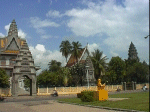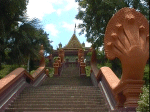Cambodia: Wat Ounalom and Wat Phnom
Created | Updated Jun 21, 2003
Founded in 1443, Wat Ounalom is the headquarters of Cambodian Buddhism. The compound, forty four buildings in all, is about 250 metres north of the Royal Palace along Sisowath Quay.

A lot of the buildings and many of the statues were damaged during the Khmer Rouge regime, but things have been repaired and have now returned to normal.
The buildings are used for a variety of purposes; there is obviously the temple itself and the stupa containing an eyebrow hair of the Buddah, but there are also schools, libraries and living quarters.
The patriarch of Cambodian Buddhism lives within the compound1.
On the day I chose to go I didn't want to investigate every nook and corner; I just wanted to wander back and forth soaking up the peaceful atmosphere. For anyone wanting to recharge their batteries after the hustle and bustle of the city I would recommend a few quiet moments here.
WAT PHNOM
Wat Phnom is set on top of the only hill in Phnom Penh.

The legend goes that the first pagoda was built in 1373 to contain four statues of the Buddah found in the river by an old woman named Penh. Gradually a town grew up around the temple and became known as the "Hill of Penh" or Phnom Penh. The temple has been rebuilt four times, most recently in 1926.
The temple itself is dominated by a massive stupa which holds the ashes of King Ponhea Yat, who died in 1467.
Nowadays, the temple is busy with people praying for luck or returning with offerings of garlands of flowers or fruit when the request has been granted.
On the side of hill is a glazed memorial, commemorating a treaty with the French early in the twentieth century; and, below that, a more modern floral clock. At the base of the hill are concrete benches under shade trees; welcome after climbing up and down the hill. There are fruit sellers and bird sellers2. Also, when I visited, there was even an elephant giving rides.
A point to note, Wat Phnom is just a short walk from the General Post Office, so it is possible to kill two birds with one stone.
